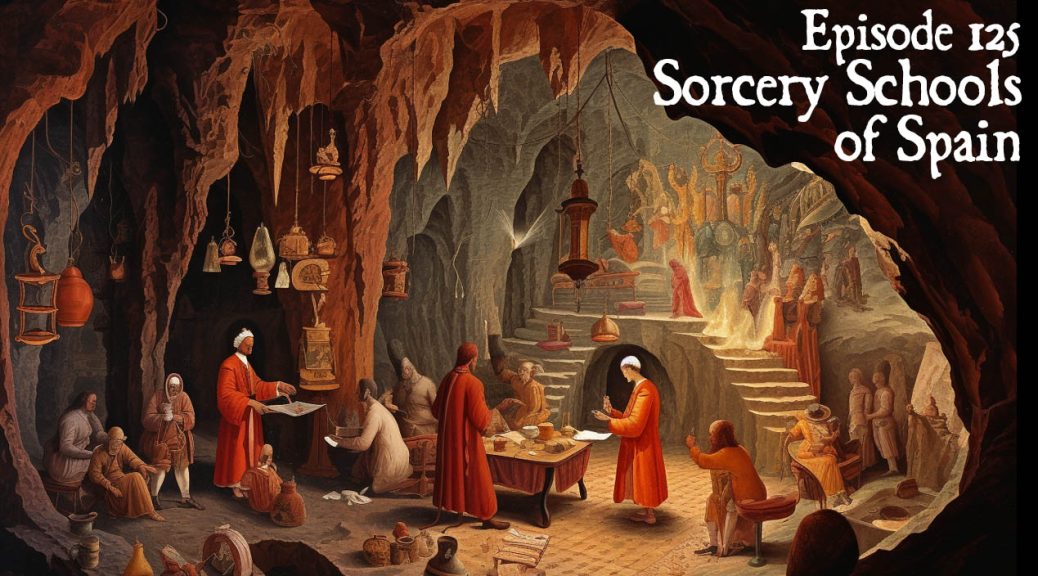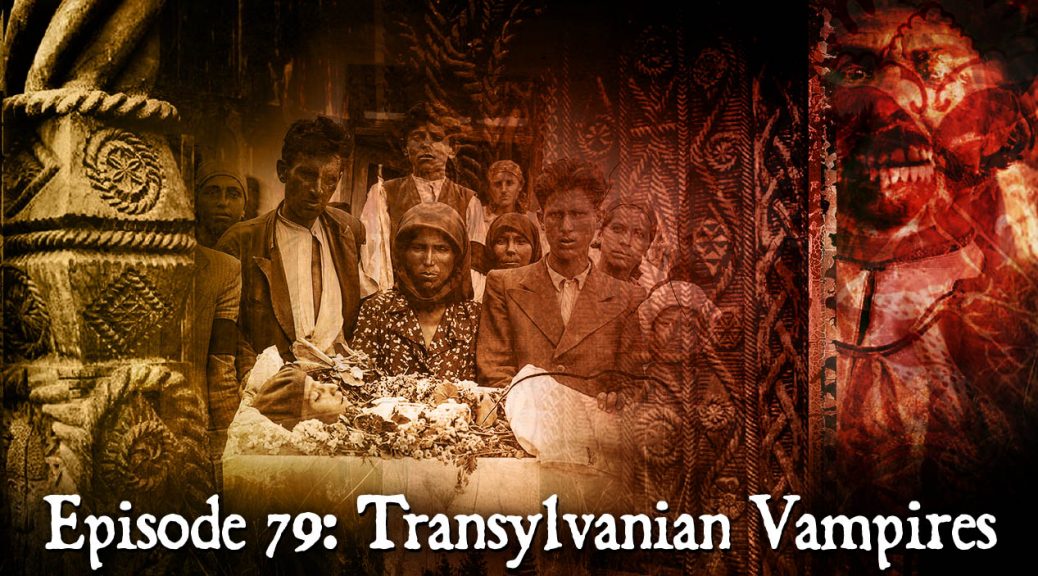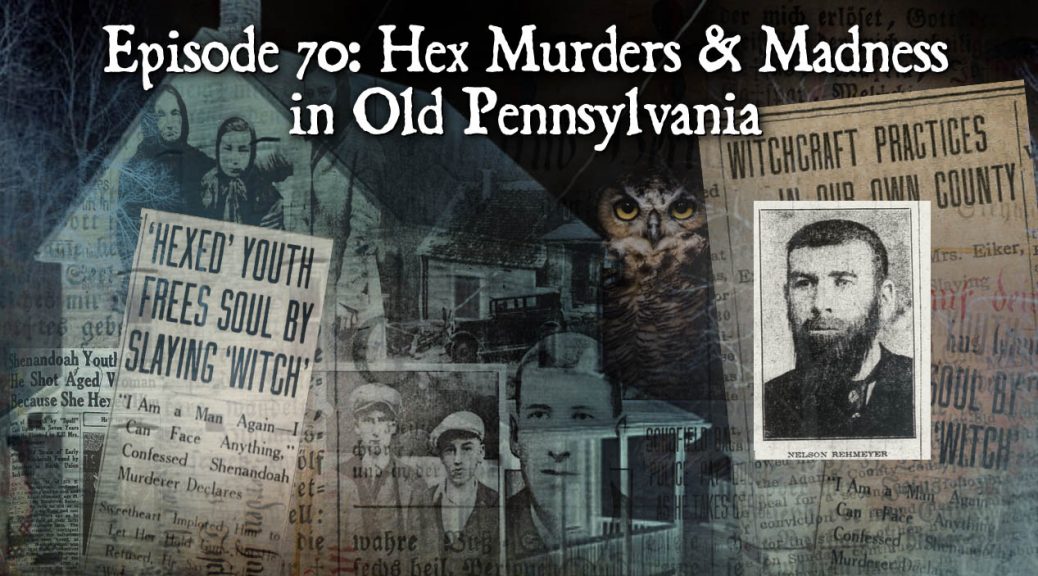
Sorcery Schools of Spain
Podcast: Play in new window | Download (Duration: 51:18 — 58.7MB)
Subscribe: Apple Podcasts | Spotify | Android | Podchaser | RSS | More
For centuries, Spain was said to be the home of secret, underground sorcery schools, Toledo being the first city with this reputation and later Salamanca. The notoriety of the latter was more enduring, and when the legend passed to Spanish colonies of the New World, the word, “Salamanca” was embraced as a generic term for any subterranean location said to be the meeting place of witches. We begin the show with a clip from the 1975 Argentine film Nazareno Cruz and the Wolf, which depicts just such a place.
A particularly early reference to this concept can be found in a romanticized 12th-century biography of a particularly interesting character, a French pirate and mercenary Eustace the Monk. Mrs. Karswell reads for us a passage written by an anonymous poet of Picardy, who describes Eustace’s occult schooling in the city of Toledo. Along with this we hear as a passage from a 1335 Tales of Count Lucanor by Juan Manuel, Prince of Villena, which adds another element to the legend, that of its underground location.
Curiously, a number of Spanish cities claim as their founder the Greek demigod Hercules, but in Toledo, he’s also credited with founding this school of magic, excavating a subterranean space in which he imparts his supernatural knowledge, at first in person, and later in the form of a magically animated sculpted likeness. Another Toledan legend, was later blended into this mythology. It’s the story in the Visigoth King Roderick, Spain’s last Christian ruler makes a discovery prophesying his defeat by the Moors in 711 CE. Along with a parchment foretelling this, Roderick exploration of this enchanted palace or tower results in the discovery of the Table of Solomon, a construction of gold, silver, and jewels also attributed with occult powers. Legends detailing this are believed to be of Arabic origin, first recorded in the 9th century and later appearing in One Thousand and One Nights. In later Spanish retellings, the treasure house is conflated with the Cave of Hercules, and the fall of Spain to the Moors is attributed to Roderick breaking of a spell woven by Hercules, to keep North African invaders at bay.

By the 16th century, this site (now identified as an ancient Roman structure underlying Toledo’s church of San Ginés) had inspired such wild tales that Cardinal Juan Martinez Siliceo organizes a 1547 expedition into a subterranean space in hopes of putting the rumors to rest, but it hardly succeeded at that. Mrs. Karswell reads a dramatic 1625 account of that misadventure.

While talking bronze heads and magic mirrors were being added to descriptions of the Toledo site, in the late medieval period, similar legends began to be told in Salamanca. Being the site of one of Europe’s most ancient universities in a time when scholars were not infrequently misunderstood as magicians, legends of this sort would naturally be associated with Salamanca. But unlike the universities of Paris, Padua, and Bologna, Salamanca’s location in Spain made it a center of Moorish learning and the study of Arabic texts filled with strange calligraphy, figures and charts readily passing for books of magic.
As Salamanca’s reputation emerged later, in an era after the witch trials had begun, instruction no longer was provided by a figure from classical mythology but from the Devil, one of his demons, or a professor or student in league with the Dark One. A favorite character filling this role was the Marqués de Villena, a scholar who’d written books on alchemy and the evil eye. Villena appears in a number of literary works of the era, both in Europe and the New World. In the 1625 play, The Cave of Salamanca, by Mexican dramatist Juan Ruiz de Alarcón, Villena figures into a scenario that became fairly standard in Salamanca stories, one involving the Devil’s payment for the lessons provided. This would be demanded in the form of a human soul, the victim chosen by lot among the seven students instructed at the end of a seven-years period.
In Salamanca, the underground location of this magic school is strangely associated with a Christian site, the Church of San Cyprian, a significant choice, as St. Cyprian of Antioch has strong occult associations throughout the Catholic world but especially in Spanish and Portuguese-speaking regions. Before Cyprian came to Christianity, this 3rd-century saint is supposed to have been a sorcerer and is sometimes referred to as “Cyprian the Magician”. His story is mirrored in Portugal by that of Giles of Santarém, and both figures appear in Spanish and Portuguese literary works in which the saints play roles parallel to that of the Marqués de Villena, and the magic school becomes “The Cave of Cyprian.”
There are also legends that the magical secrets of the pre-conversion Cyprian were preserved, and on the Iberian Peninsula particularly (but also prominently in Scandinavia) grimoires and spell books attributed to Cyprian began circulating as early as the 16th century. After a brief look at the history of these magic books, we turn our attention to the New World and their legacy there. In particular, the use of such books in Portuguese folk magic brought Cyprian the Magician to Brazil where, where he was absorbed into the syncretic religions of that country. The practice of Macumba, one of these religions synthesizing West and Central African beliefs with those of Catholicism, and 19th-century Spiritism, Cyprian the Magician is transmogrified into São Cipriano dos Pretos Velhos, or Saint Cyprian of the “Old Blacks” an embodiment of the departed African Ancestors. Our show ends with a Macumba chant dedicated to this figure and a Spanish prayer to St. Cyprian for protection against witches, curses, and the evil eye.













